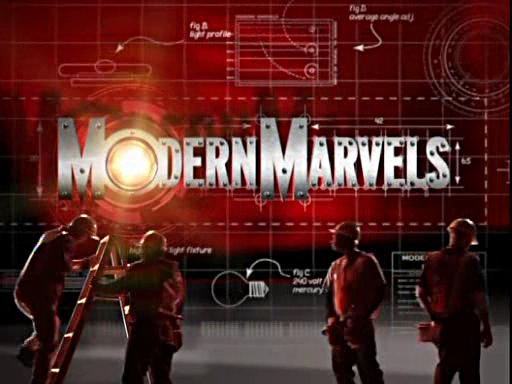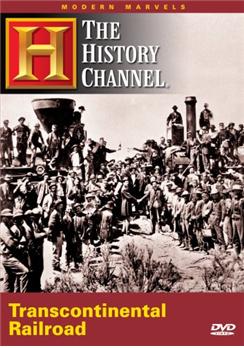Modern Marvels: Celebrating How It Works
Janet Wasko and Carlos Calderon / University Of Oregon

“Celebrating ingenuity, invention and imagination brought to life on a grand scale, MODERN MARVELS tells the fascinating stories of the doers, dreamers and sometime-schemers who created everyday items, technological breakthroughs and man-made wonders.”1
Documentaries were pretty much an afterthought in the 1950s and ’60s when ABC, CBS and NBC dominated commercial television in the U.S. and sitcoms, westerns, variety shows, an occasional drama, and quiz shows pretty much dominated prime time television.
As a result, documentaries were few and far between, and were often relegated to weekends. Two series stand out, however. Victory at Sea was a documentary about naval warfare in World War II, highlighting the U.S. Navy in a 26-episode series which had a then-unheard of budget of $500,000. The series first aired on Oct. 26, 1952, and ended May 3, 1953, featuring the music of Richard Rodgers.
The Twentieth Century was a weekly documentary, which aired on late Sunday afternoons, and showcased a host with a deep and compelling voice by the name of Walter Cronkite. The weekly show opened with a V-2 rocket blasting off from White Sands Missile Range and shooting into the stratosphere and it featured important events, many of them battles from World War II. It was the flagship of television documentaries and catapulted Cronkite into the country’s most trusted television news person.
But as the American television market has become increasingly fragmented with the advent of cable and satellite television, a number of channels and networks now specialize in documentaries that often appeal to viewers tired of mindless sitcoms and mind-numbing reality shows.
Modern Marvels, which airs several times a week on the History Channel, is an on-going documentary series that offers in-depth explorations how things work, exploring technological and engineering wonders, as well as how a wide array of products and services are produced. One description of the series notes that the focus is on “historical technology.”

Modern Marvels appears on the History Channel, which is one of the A&E Television Networks (AETN). AETN is a joint venture of The Hearst Corporation, ABC, Inc. and NBC Universal. The company is involved in television programming, home videos/DVDs and music CDs, and Web sites.
AETN includes A&E Network, The History Channel, History International, The Biography Channel, The History Channel en español, Military History Channel, Crime & Investigation Network, A&E HD, AETN International, and AETN Consumer Products.

The Modern Marvels series debuted on January 1, 1995, and has produced more than 450 episodes since then. Thus, the range of topics that has been covered is immense. An overview from imdb.com reads: “The series has focused on the wonders of construction (Erie Canal, the Pentagon, the Chesapeake Bay Bridge, the Big Dig), the machinery of war (nuclear submarines, tanks) as well as technology linked to the everyday (power tools, home tech, garbage).” Past programs have explored various forms of transportation, technological and architectural wonders, as well as engineering disasters. Forthcoming episodes focus on corn, magnets, farming technology, and the Pacific Coast Highway. Other recent shows have explored bread and rats, as well as bathroom technology, and deep freezing. One of the taglines reported for the series is: “If it changes your life, chances are it’s a Modern Marvel!”
Based on the number of episodes produced, the series obviously has been successful. Average total viewers in prime time are reported to be 1.2 million this year, up 28% from 2007.2 As one viewer explained on a fan website: the show is “oddly addictive.”3
From the success of Modern Marvels, the History Channel has developed an entire genre of “how it works programs,” including Where Did It Come From?, Wild West Tech, and Tactical to Practical (military solutions turned into everyday products). Meanwhile, The Discovery Channel offers Really Big Things and the Science Channel has How It’s Made and Cool Stuff: How It Works.
An example of the “how it works” phenomenon in another medium is the website, HowStuffWorks, which has recently become a part of Discovery Communications. The site is described as, “…the award-winning source of credible, unbiased, and easy-to-understand explanations of how the world actually works.”4 HowStuffWorks is reported to have become the focal point of Discovery’s digital activities, as the company plans to create “a fully multimedia version of an encyclopedia, with content and video that will answer virtually any question an Internet user might have.” A HowStuffWorks program on the Discovery Channel is currently in preparation.
One of the positive features of these “how it works” documentaries and sites is the demystification of industrial and commercial processes. In other words, viewers are introduced to what is actually involved in the production and distribution of everyday products and services. The resources involved – including labor – in the production of commodities become more transparent, emphasizing the point that consumer products don’t just “fall from the sky” or appear magically on super market shelves.
While Modern Marvels does a generally good job of presenting an historical background for most of the topics explored, the show walks a fine line in its relationship to the producers of the various products and services explored in some of the programs. Of course, the Modern Marvels producers rely on these sources for content and footage for the programs and such access might become problematic if an overtly critical tone is adopted.
However, the program sometimes finds itself blatantly crossing the line. A recent example is the addition of new segments in several existing shows to feature Cisco Field, the new home of the Oakland Athletics. Cisco Systems is one of the program’s on-going sponsors. As one television commentator noted: “History’s adding new segments to an existing show for a sponsor is a new wrinkle in the trend of marketers looking for ways to embed their messages into programming.”5 The deal also included a three-minute mini-documentary (“advertorial”) about Cisco Field produced by the cable network that appears during the programs, as well as on history.com.

In addition, the show seldom provides any kind of critique of the corporations involved or any of the dubious processes that are involved in producing and distributing some of our “modern marvels.” An example: several shows on snack foods avoid any serious comments about the problem of overeating and obesity in the US these days. Perhaps not too surprisingly, overt critical commentary about environmental and other impacts of the featured marvelous creations of mankind is often missing from these programs, as well.
Despite the lack of critical commentary and the obvious ties with corporate America, many of Modern Marvels episodes still may prompt viewers to think about how modern societies are organized and maintained. And even though we risk the scorn of avid American Idol and Survivor fans, Modern Marvels seems far less annoying and even somehow more “entertaining” than much of the other drivel that American television currently offers.
Image Credits
2. Modern Marvels Transcontinental Railroad
4. Cisco Field
Please feel free to comment.
- http://www.history.com/minisites/modernmarvels/ [↩]
- Jon Lafayette. 2008. “Altering History to Woo Ad Partners: Cable Channel Re-Edits ‘Marvels’ With Cisco Content,” http://www.tvweek.com/news/2008/03/altering_history_to_woo_ad_par.php [↩]
- http://www.imdb.com/title/tt0199248/usercomments [↩]
- http://www.howstuffworks.com/about-hsw.htm [↩]
- Lafayette [↩]